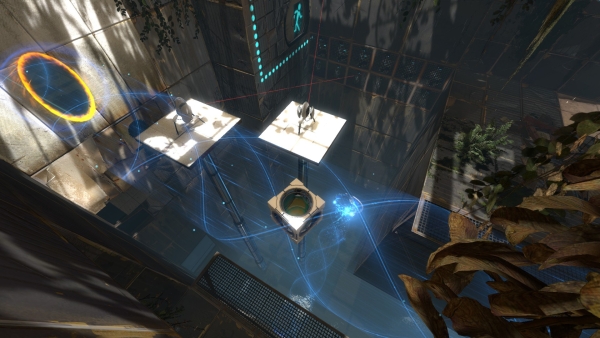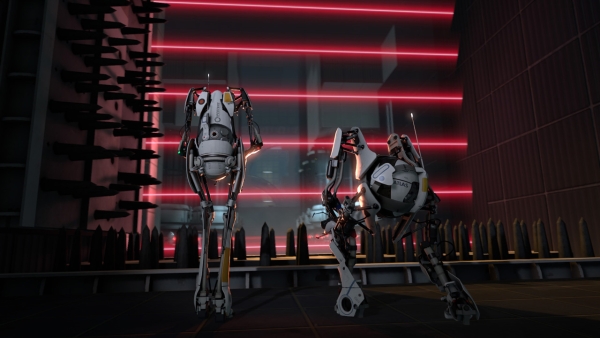
When Portal 2 was announced, the question wasn’t whether or not it would be good, but whether or not it would be successful. As a sequel to a short game that was added in as an extra on The Orange Box, many people wondered if it could live up to the original and if it was worth making a sequel. But Valve has done it again – they’ve given us a game rich with story and full of new and interesting gameplay. It still remains within the Aperture Science universe, and it still has that same self-contained story, but now it’s been expanded further. Portal 2 is a monumental success, and should be an example for how sequels can succeed under the right guidance and passion.
Platforms: PC, PS3 (Version Played), Xbox 360
Publisher: Valve
Developer: Valve
Genre: Portal-Placing Puzzle-Platformer
Release Date: April 19, 2011
ESRB Rating: Everyone 10+
The original Portal came out back in 2007 and made a splash instantly. Valve delivered a story within the confines of a laboratory, with a female protagonist and a deranged antagonist. The game instantly spawned memes about the cake being a lie, and propelled Chell and GLaDOS into instant fame. Fast-forward the story an unknown amount of time, and you wake up again as Chell, only now, in the wake of GLaDOS’ defeat, the testing center has fallen into disrepair. You’re initially confronted with a friendly, if slightly obnoxious, AI named Wheatley, voiced by comedian Stephen Merchant. After a quick tutorial, you’re reunited with your trusty portal gun, and things really start to heat up.
I don’t want to give any spoilers about the story, which blew my expectations away. There’s the return of GLaDOS, but there’s also Wheatley and another new character, the President and CEO of Aperture Science, Cave Johnson. Johnson is hilariously and appropriately voiced by J.K. Simmons. We wrote about him in our interview, but he comes to life in the story, becoming far more than just a voice – he takes on a life of his own as you progress. Each of these characters help to weave an intricate story, keeping the same self-contained feeling as before, but expanding it and letting it grow in ways I never imagined it could.
When it comes to gameplay, I wasn’t sure what to expect at first. How much more could they expand it from the first game? What new functionalities could they open up for us to explore? Many of the main gameplay elements remained, like using portals to fling Chell to higher platforms and/or over hazards. As always, it’s a tricky but satisfying action, calling in precision portal-shooting to line then up properly and get the right amount of momentum going. New to the series are Excursion Funnel Tractor Beams as well as Hard Light Bridges – Chell can ride the tractor beams (and sometimes change their direction), and she can walk across the bridges. She can also use the bridges to block shots from turrets, which are back, and are as adorably unsettling as ever. These new features give each test a new dimension, as you have to think vertically and horizontally while taking into consideration all the other elements.

Cubes are still available to help you solve puzzles, and now there are also Redirection Cubes, which have reflective surfaces that can redirect Thermal Discouragement lasers, allowing you to destroy turrets and/or power up various items, like cube delivery systems or doors. Lining up lasers through portals can quickly lead to laser entanglement. Aerial Faith Plates are also new, and launch you, and other objects, into the air around the levels. Mix these with portals and the flinging mechanic to bring momentum to a whole new level of insanity. But the best additions to the game are the gels.
The blue liquid, called the Repulsion Gel, creates bounce pads so the player can reach higher areas. The physics are set up so that whatever level you fall from is however high you can jump, so you have to use the gel mixed with portals in order to achieve your goal. Items also interact with this, which can cause pandemonium. The red liquid is the Propulsion Gel, which makes the ground slippery so the player can go faster and propel themselves across gaps. Mix this with Repulsion Gel, portals, and one particularly huge test, and you have one of the most fun levels in the entire game. The best by far was the white liquid, the Conversion Gel, which allows the player to make portals anywhere the gel hits. That, by far, was my favorite new addition to the Portal repertoire, and the one I spent the most time messing around with. Before I knew it, I would have covered half the floor of an entire test in Conversion Gel, making portals everywhere, completely forgetting my objective. (That never got old, either.)
The single player campaign is a masterpiece of gaming. Valve spends the entire first half of the game trying to bend your brain to think inside the box, and then the second half of the game they unravel that, forcing you to think outside of it. This is similar to the way things went in the first game, except now it’s bigger, more expansive, and you’ve got Cave Johnson with you every step of the way. But nothing ever beats GLaDOS. “Here are the test results: you are a horrible person. A horrible person! We weren’t even testing for that.”

The cooperative campaign is one of the best co-op experiences I’ve ever had. You play as two robots, Atlas and P-body, who have different colored portal guns – one is blue/purple, while the other is orange/red. The tests are trickier now, but force the players to join forces in order to solve complex puzzles and make it to the goal together. It can be a fantastic team-building experience, bringing friends and loved ones closer, or it can easily lead to broken relationships. Communication is key here, and the ability to mark where you want your partner to place a portal makes things exponentially easier. Waving, hugging, high-fiving, and dancing are also staples of the robots’ communication, which GLaDOS does not approve of at all.
The co-op campaign also has its own unique storyline. GLaDOS chastises and admonishes the robots for everything, while also using them to gather discs for her in places she can’t get to. Unlike the single player campaign, in which you restart at a checkpoint if you die, new robots can be quickly assembled, allowing you to hop right back into play and continue with the story without much of an interruption.
The voice acting in this game is absolutely top-notch. Simmons steals the show, belting out hysterical lines so perfectly I was in stitches. Ellen McLain’s performance as GLaDOS is also incredible, her derisiveness towards Chell nearly tangible. The music is also fantastic. Jonathon Coulton lends his song-writing skills again, and The National’s haunting song “Exile Vilify” fits right in with the mood of the game.
Portal 2 is one of those rare games that allows and encourages the intuitive and curious nature of the gamer to come out and achieve its full potential. The game is full of “I can’t believe I just did that!” moments that culminate into a rich and satisfying experience, moments that are more “ah-ha!” than they are frustrating. At the same time, it does nothing to dilute or make the first game irrelevant in any way. Valve found a way to take everything that worked in the first game and create a new game that was a true sequel and not just “Portal 1.5.” This is an experience that no gamer will want to miss.

Review Disclosure: A retail copy of Portal 2 was purchased by Warp Zoned for the purposes of this review.







